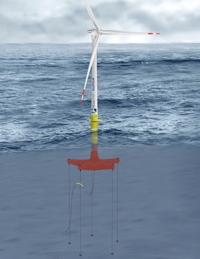The South West of England is making the most of its coastline to take a lead in marine renewables and an event tomorrow aims to bring businesses closer to opportunities in that sector.
Cornwall Council’s MERiFIC project is hosting an event for businesses and organisations interested in marine renewable energy development at Plymouth University’s COAST Laboratory, a facility that includes an ocean wave basin, coastal basin and sediment wave flume.
Taking place between 4pm and 6pm, the event will provide businesses with the chance to gain a greater understanding of the marine energy sector and meet key stakeholders from the UK and from France involved in exploiting marine renewables.
Last week around £2m of Convergence European Regional Development Funding (ERDF) was made available for marine renewables companies and Cornwall’s FaB Test and Wave Hub exist already for those working on concept or prototype development; as well as early stage demonstration or deployment of marine renewable devices.
FaB Test is a non-grid connected nursery test site in Falmouth Bay off the south coast of Cornwall for the testing of components and devices. Wave Hub is a grid-connected offshore marine energy test site located 10 miles from the north coast of Cornwall. It has been built for full-scale technology testing, including floating offshore wind turbines.

The Energy Technologies Institute (ETI) plans to use the facility to test a tension leg platform (TLP) designed by Glosten, a US-based naval architecture and marine engineering firm taking part in the development of a deep water wind turbine.
According to ETI, the PelaStar TLP prototype will be developed in partnership with Alstom using their Haliade 150-6MW offshore wind turbine.
Harland and Wolff in Belfast has been chosen by Glosten as the builders for the demonstrator and the TLP will be designed for potential deployment at Wave Hub. ETI add that the demonstrator will likely be operated for eight to 10 years to allow further design modifications and refinements to take place.
One tried and tested source of energy is very much on the agenda at a two day conference taking place today and tomorrow.
The Bristol-Oxford Nuclear Research Centre and the UK Project on Nuclear Issues are convening to explore and enhance the relationships between nuclear stakeholders in the policy and technology arenas.
The conference will discuss issues of concern to nuclear policy-makers and nuclear technicians, identifying ‘areas of interaction which would benefit from further coordination’. It will also provide young, emerging nuclear specialists with the opportunity to present before, learn from, and network with experts from other nuclear fields.
The UK is embarking on around £60bn of new investment in new nuclear and last Tuesday EDF Energy were granted planning consent to construct two new reactors at Hinkley Point C in Somerset.
This Sunday, however, sees the formal closure of a power station whose source of fuel is viewed by a great many people (and legislators) as synonymous with greenhouse gas emissions and global warming.
E.ON’s Kingsnorth power station ceased commercial operation in December 2012 and decommissioning and closure work has been taking place at the former coal fired plant since that time.
Kingsnorth fell foul of the EU’s Large Combustion Plant Directive legislation, which orders plants not adapted for emissions-reduction targets to close by the end of 2015 or when they use up 20,000 generating hours from January 2008.
In February The Engineer reported on a competition designed to ‘embed innovation in Britain’s rail industry’
Run by Frazer-Nash, the Radical Train Competition calls for proposals from industry that show how a significant step change in the performance of trains on UK railways can be made, and to develop train systems and sub-systems with export potential.
The engineering consultancy has been in touch to let us know that the competition is now open to applications and that the best ideas will go forward to a demonstrator project.
They’re urging those considering entering ideas to do so as soon as possible, adding that early entrants ‘will benefit from feedback during an eight week dialogue phase and a selection will be invited to a briefing on the 21st of March to discuss the goals for Radical Train and the process the project will follow.’
Click here for more information about the competition.
IBM and ASTRON are looking for scientists to take part in what they describe as the world’s biggest Big Data challenge – researching the origins of the universe.
The organisations have been in touch to say they are inviting professors, scientists and qualified university students to participate in a virtual recruiting event tomorrow for several open positions on the DOME project.
DOME is a five-year collaboration between IBM and ASTRON, The Netherlands Institute for Radio Astronomy, to research extremely fast, but low-power exascale computer systems targeted for the international Square Kilometre Array (SKA), an international consortium to build the world’s largest and most sensitive radio telescope.
Finally, Hampshire student Emma Willett beat a field of 450 competitors to claim the EEF Manufacturing Prize at the recent National Science + Engineering Competition.
The student was unveiled as the winner at The Big Bang UK Young Scientists & Engineers Fair, held at the ExCeL International Convention Centre in London. She received her award from Phil Brownsord, Region Director of EEF.
Willett is said to have captured the attention of the judging panel with her saucepan overheating alarm; a device which fits on to any saucepan to provide an audible and visual warning if the pan is overheating and in danger of boiling dry. The aim is to reduce incidents in which this causes household fires.
As well as receiving £500 and a certificate, Emma will also receive a day’s experience at William’s F1 technology campus.





Glasgow trial explores AR cues for autonomous road safety
They've ploughed into a few vulnerable road users in the past. Making that less likely will make it spectacularly easy to stop the traffic for...